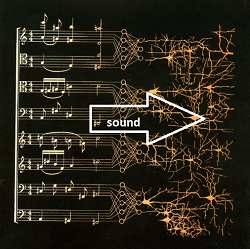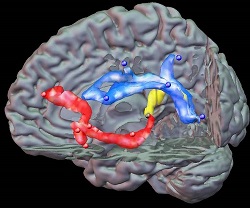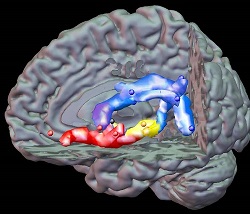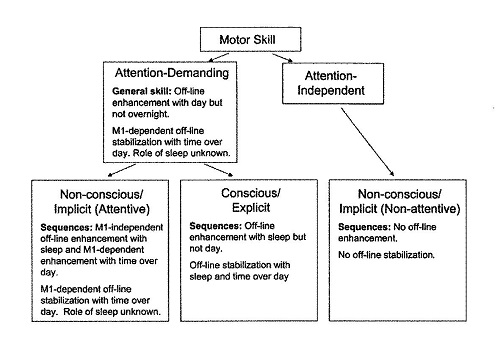The idea that the brain plays the music sounds weird at first glance. However, what is behind that idea? Of course, the brain governs all conscious activities. Therefore, without any participation of the brain one cannot make or think of music at all. Thinking as well as any motor activity engaged in playing a musical instrument is based on a cognitive process which originates from the brain. Even more musical thinking or the pure imagination of music provokes a musical action. Consequently, there is no music without a link to the brain. But does it play the music? Yes and no – it plays because of the motor activities initiated by the human brain, but it is of course much more than only the brain that plays the music, it is the entire body and the human mind with all its physical and emotional implications that produce the sounds we pretend to be music.
Beyond that, it is even more complicated. The ear only receives air waves (vibrations) as the physical condition of sound. Auditory neurons respond to this vibration and fire when they are stimulated. The musical mind perceives (interprets) the innervation of the vibration between 0.002 and 20 kHz as sound (other frequencies of electro-magnetic waves are perceived quite differently). However, the perception of acoustic sensations is only the first step towards music. Here, the brain decodes the incoming spectral sound information according to the mental sound propagation. This is the external neural excitation of perception which, then, needs to be transformed into an internal process of musical cognition which brings the meaning to the sound. This surplus of information processing is the result of experience gained through social and cultural exposure, and through education and training as well. In short: we perceive sound, but we hear music. And the music which we believe to hear exists only in our minds; there is no external equivalent to what we hear, recognize, and understand. Therefore, the essence of what we hear and recognize is individual and differs considerably between individuals according to their particular musical socialization and experience which has been stored as mental representations in the brain and determines the musical mind.
Perception Cognition


Figure 1
The transformation from sound to music through cognition. The musical score represents a piece of music the sound of which is perceived and processed by the neural network of the brain. Then, the brain overdetermines the pure sound information and adds something from the musical mind to generate a musical meaning.
Instrumental practice and the brain
Music performance (and to a certain degree also conscious music listening) belongs to the most complex and demanding cognitive challenges to the human mind. Music has an immediate and strong impact on the brain due to the high adaptability of the brain according to the environmental demands which is designated as brain plasticity. Musical practice provides a salient example of brain plasticity because it induces structural (anatomical) and functional changes in the cortex. Consequently, music does not only arouse aesthetic pleasure, it also functions as a cognitive stimulation which evokes many effects in cognitive and executive functions (Bherer, 2015; Bigand & Tillmann, 2015).
To understand the high complexity of a musical performance, i.e. the corporeal execution of music by the player, I will give an example. Let us assume a musician (adult or child) who plays a simple tune with a chord accompaniment on the piano. In doing so the person needs to read the score (visual information) and associate the symbols with the sound and the fingering on the keyboard (aural and motor association). This requires eye-hand coordination and the link between a symbol, its sound and a motor action (fingering). To anticipate the sound is necessary for an appropriate phrasing and dynamics. Then, the movement needs to be controlled in terms of a steady beat (time dimension) to perform the right meter and tempo. Similarly, the movement of both hands must be coordinated in time (motor coordination). If one intends to stress single tones in the melody these tones need to apply heavier weight on that finger and to increase the velocity of the finger movement. This is a very complex motor activity which is controlled by the ear (auditory-motor link). For this, the player needs to anticipate the sound of the next tone or chord which enables him to identify whether it is correct or not and then to eventually correct it. Finally, this has to be carried out not mechanically, but implies emotional expression and communicative interaction.
Just this simple example of playing an ordinary tune shows that several brain areas get involved in this activity: the visual and auditory cortices, the motor and sensori-motor areas, and the emotion system just to name the most important ones. This is even more complex in more complicated actions such as playing a tune on the violin where intonation becomes a key issue. Here, the anticipation of the sound that will be produced next is as important as the immediate correction if that tone is not in tune (fast reflexes). This needs to be done so quickly (extremely short reaction time) that the listener does not realize the false note, that means the correction should be faster than the cognition.

Figure 2
Interactions and activations of violin playing (from Zatorre, Chen & Penhune: „When the brain plays music”, Nature Neuroscience 2007, 548, With permission of © Nature Publishing Group).
Three main cognitive activities need to be applied to the production of a melody: timing, sequencing, and spatial organization (Zatorre, Chen, et al., 2007). First, the musician has to put his fingers at the right time on its proper place of the finger board. This calls for a clear and pronounced time organization. Then, all single events and actions need to be arranged in a strict sequential order that makes the tune. And finally and most importantly, the violinist moves his fingers within the spatial topography of the instrument. He develops a clear image of the distances where to put the fingers especially after a position change. This demands a proper coordination of space, time and sound which can only be achieved through persistent musical practice. This establishes the mental representations of all musical actions and gestures which, then, need to be coordinated.
The real motor activities can also be replaced by mental imagery (mental practice). Here, a musician executes any simple or complex action only in his imagination. For this, he needs to be experienced with the respective motion so that it can be performed mentally. In mental practice the same muscles are innervated as in real motion. Therefore, a child or musician can sing silently a piece he wants to play and can imagine all of the particular movements as if he would perform it in real time.
This helps to develop a formal representation of the piece. A representation can be either figural or formal (Bamberger, 1991). In figural representation one follows the concrete sequence of tones step by step and imagines the parts as units in terms of fingerings or keys etc. In formal representation the piece is represented independent of a concrete realization, e.g. an arpeggio of a dominant seventh chord can be imagined as a type or structure or just the sound independent of a particular instrument or tonality.
All musicians, especially young children, start with a figural type of representation and need concrete marks (strings, keys, bells, names) to follow. The emergence of a formal representation is a consequence of learning by which the cortical areas are replaced and minimized by subcortical areas. Learning in general can be defined as the process of transforming a figural into a formal representation. Mental practice and thinking of sounds facilitates this development.
When we look at the modes how the brain is involved in playing the music we should also look at the way how the brain processes the music we listen to. In recent decades there was an enormous progress in the understanding of the architecture of the brain and the identification of areas and their interaction. Now, we can access a detailed brain map where all human activities are localized. However, when we look for music, there is no music center in the brain. As mentioned earlier, music is a demanding challenge to the entire brain especially to the two hemispheres which are connected by the corpus callosum which is thicker in musicians compared to non-musicians.
Since music is an acoustic phenomenon, the primary auditory cortices are involved; but because of the hierarchical syntactic structure at least of tonal music it has overlapping areas with language for the representation and production (Patel, 2008). Figure 3 shows the two (dorsal and ventral) pathways for processing language and music and how much they use partially the same fiber connections.
Language Music


Figure 3
Pathways for language and music (left hemisphere). With permission of M. Musso, University of Freiburg.
Therefore, it is plausible that singing and speaking use the same mental sources for the articulation of vocal sounds (Gruhn, 2008; 2009). Other neural assemblies respond to pitch and loudness, sound direction and movement, timbre and sound qualities. All the different psychoacoustic elements are represented separately, but are integrated holistically when processed. This is even more the case when we take into consideration the visual aspect of music reading and motor activities. The interaction of brain areas becomes apparent in the eye-hand and the auditory-motor coordination.
Brain responses to contemporary music
All of these activities function independently from any style or genre in music. The brain does not differentiate between contemporary or ancient music, not between the sound of a violin or an oboe, it can only process spectral pitch information. Then, it is the musical mind that recognizes a sensorial input as a particular instrument or type of music, e.g. a march or a dance, a choral or an experimental electronic sound installation etc. . This recognition is the result of the developing musical mind that generates the meaning. How does that work? Listeners as well as practitioners develop a repertoire (or: „vocabulary”) of musical patterns they work with. In traditional tonal music this „vocabulary” builds a standard type of musical grammar. While listening we match the incoming sound with the already developed patterns of that grammar. If it matches, we „understand” a period as a period, a syncopation as a syncopation. However, in many forms of contemporary music there is no longer a standard „grammar”. Therefore, the performer and listener needs to find out about the musical rules and the structure of sound patterns that match with the heard or produced sound. Musical cognition is based on pattern matching. If there is nothing what can be assimilated we need to generate a new system that governs the actual structure.
However, the brain only responds to frequency, volume, spectrum, and time, but the musical mind tries to generate a „meaning” according to the sound structure. Consequently, listeners rely in a first instance on very basic parameters. They recognize changes in loudness and pitch, in dynamics and time structure. It is a question of the physiological and individual limits regarding the perception of very small frequency differences that enables listener to deal with micro-intervals which are often used in contemporary compositions. All of these basic perceptions are associated with common emotions. Therefore, one can enjoy the sound of an instrumental composition without referring it to a general established structure. In avant-garde music, each composition creates its own cosmos of structural possibilities, and it is the demand on the audience and the satisfaction for a listener and performer to find out about it. A continuous experience with contemporary structures helps to develop a mental representation and to generate a categorical system of acoustic sound parameters, musical structures, and compositional events that culminate in the development of mental representations of contemporary sound patterns that can and need to be activated in music listening. However, the brain processes within the neural networks do not differ between particular styles and genres.
In improvisation, we realize the same problem. Here, a musician performs an instant composition by arranging sounds and developing musical ideas in real time. This calls for a clear mental imagery of what is intended to produce. In a group improvisation reaction becomes essential, but not in terms of physical reaction time (neural conduction speed), but as the communicative quality of the interacting processes which depend on musical experience and proficiency. In brain scanning experiments it could be shown that composing and improvising engages a higher, wider distributed and a more densely interconnected neural network compared to playing and listening (Petsche, 1997).
Mental processes and emotions
Finally, all of these perceptions and performances are embedded in and accompanied by expressive emotions. Here, the different aspects of valence (quality: positive or negative) and arousal (strength: strong or weak) are represented in different areas of the limbic system. Especially the amygdala which is involved in fear and anxiety is strongly affected by music. Music turns the amygdala off. Therefore, children unconsciously sing when they are required to go into a scary basement or timidly across a dark forest.
A different kind of anxiety matters in stage fright (or: performance anxiety). Here, the amygdala is also active, but the primary source of anxiety is not to stay on stage and see the audience, rather the increased stress level that causes the anxiety to become unable to play because of trembling or other psychophysiological reactions. This is a serious problem for all musicians, but quite different from fear caused by an unpredictable threat. Therefore, singing does not help to overcome stage fright. In this connection musicians need to control the unbalanced stress factors by body exercises of breathing and relaxation.
General principles of brain based learning
What is learning? There are many divergent definitions and descriptions depending on different philosophies and learning theories. From a neuroscientific point of view, learning starts on a very basic molecular level where neurons build connections through synapses to facilitate or inhibit information transmission. The mental capacity, therefore, depends on the growth of synapses at a given time (open window for a particular brain development), on the mental speed of information conduction, and on the offer of enriched opportunities to support the natural brain development. However, instead of listing all the areas that are somehow involved in music perception and music production and instead of summarizing all activities that fall under the rubric of brain based learning, we will focus the attention to few, but important principles of learning according to the knowledge of how the brain works which is often addressed as brain based learning.
First, we know how strongly movement and musical activities are linked. This is very plausible since the vestibular system (body and movement) and the cochlear system (aural perception) are localized in the same organ, the inner ear. In a recent study we could demonstrate that musical abilities and motor abilities interact (Gruhn, Herb, et al., 2010). Children who perform high scores in motor skills (such as motor coordination, fine motor integration, short reaction time, good body awareness) reveal also high scores in a musical ability test and in their rhythmic and tonal performance skills.
Therefore, the integration of eurythmic education into music education becomes evident. Many different kinds of movement, relevant to musical gestures, should be connected to music learning more intensively because they will help to develop mental musical representations.
This is obvious in the daily practice of a musical instrument consistently over a long period of time. If we look at the champions in any domain of human activities (sport, chess, dance etc.) who have already achieved expertise we discover the same principle of a necessary amount of practice time within the first 15 years of engagement in a particular domain (expertise model) (Ericsson, Krampe, et al., 1993).
However, we also know that permanent practice with mechanical repetitions is counterproductive and may cause a decrease of achievement. From brain research we know that phases of rest result in a consolidation of an achieved skill; one can even state that rest is a prerequisite for consolidation. It has been shown that attention demanding, conscious activities which are acquired explicitly and practically hold the best effect for consolidation after sleep (see figure 3, middle box in last row) (Song, 2009). This can be easily applied to instrumental practice. After focusing the attention to the intended technical aspect of a piece and having made explicitly clear the technical solution we have the best expectation for a consolidated effect after rest.

Figure 3
The effect of consolidation of motor skills after sleep (from Song, 2009, 183).
However, more than any neural condition of the brain counts the intrinsic motivation to play an instrument (or sing or dance) and the environmental condition, namely the parental support (McPherson, 2005) which accompanies and maintains a child’s effort to practice and perform music on the highest possible level according to the individual potential. Brain based learning is not a recipe for teaching as it is not for learning. Rather it is the combination of internal and external factors, i.e. of motivational and personal traits and environmental support by family, teachers, peers etc. that presents the most valid prediction of a successful development of musical skills.
References:
Bamberger, J. (1991). The mind behind the musical ear. Cambridge MA: Harvard Univ Press.
Bherer, L. (2015). Cognitive plasticity in older adults: effects of cognitive training and physical exercise. In E. Bigand, B. Tillmann, I. Peretz, R.J. Zatorre, L. Lopez, & M. Majno (Eds.), The neurosciences and music V (Vol. 1337, pp. 1-6). New York: Annals of the New York Academy of Sciences.
Bigand, E. & Tillmann, B. (2015). Introduction to The Neurosciences and Music V: Cognitive Stimulation and Rehabilitation. In E. Bigand, B. Tillmann, I. Peretz, R.J. Zatorre, L. Lopez, & M. Majno (Eds.), The Neurosciences and Musiv V (Vol. 1337, pp. vii – ix). New York: Annals of the New York Academy of Sciences.
Ericsson, K.A., Krampe, R.T. & Tesch-Römer, C. (1993). The role of deliberate practice in the acquisition of expert performance. Psychological Review, 100(3), 363-406.
Gruhn, W. (2008). Who can speak can sing. Proceedings of the 22nd Intern. ISME Research Seminar (pp. 229-236). Porto: Escola Superior de Educação Politécnico do Porto.
Gruhn, W. (2009). The audio-vocal system in song and speech development. In R. Haas & V. Brandes (Eds.), Music that works (pp. 109 – 117). Wien, New York: Springer.
Gruhn, W., Herb, U., Minkner, C. & Gollhofer, A. (2010). Do motion control and motor coordination interact with musical abilities in young children? Paper presented at the International Conference on Music Perception and Cognition (ICMPC), Seattle.
McPherson, G. (2005). From child to musician: skill development during the beginning stages of learning an instrument. Psychology of Music, 33(1), 5 – 35.
Patel, A.D. (2008). Music, language, and the brain. New York: Oxford University Press.
Petsche, H. (1997). Musikalität im Blickwinkel der Hirnforschung. In J. Scheidegger & H. Eiholzer (Eds.), Persönlichkeitsentfaltung durch Musikerziehung. Europäischer Kongress für Musikpädagogik, Luzern 1997 (pp. 81 – 96). Aarau: Musikedition Nepomuk.
Song, S. (2009). Consciousness and the consolidation of motor learning. Behavioural Brain Research, 196(2), 180-186.
Zatorre, R., Chen, J.L. & Penhune, V.B. (2007). When the brain plays music: auditory-motor interactions in music perception and production. Nature Reviews Neuroscience, 8, 547-558.
Wilfried Gruhn, Dr. phil., professor emeritus of music education at the University of Music Freiburg, Germany. Studies in music education, musicology, psychology and German literature. He was co-editor of several German journals of music education and is a member of several national and international societies for music education research, 1995-1997 President of RAIME (International Research Alliance of Institutes for Music Education), 2000 – 2004 Board Member of ISME, 2009-2012 President of the International Leo Kestenberg Society. Beside the history of music education his research focuses on music learning theory, music perception and cognition, and the neurobiology of music learning.










